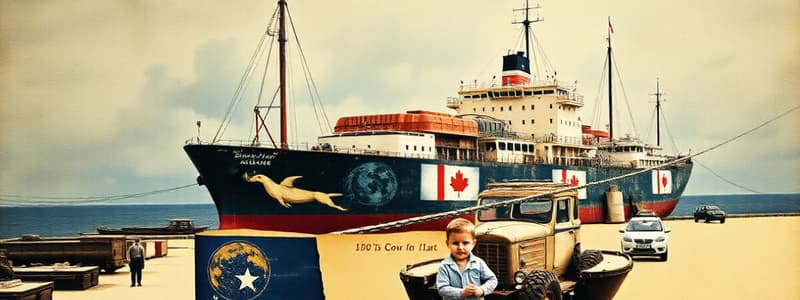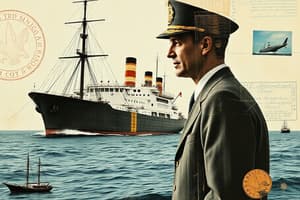Podcast
Questions and Answers
Which types of vessels are explicitly excluded from the STCW Convention regulations?
Which types of vessels are explicitly excluded from the STCW Convention regulations?
- Cargo ships engaged in international trade
- Pleasure yachts not engaged in trade (correct)
- Passenger ferries operating on fixed routes
- Government-owned vessels on commercial service
A maritime administration discovers that a training establishment is not meeting the standards set by the STCW Convention. According to the text, which entities does the STCW Convention directly apply to regarding this issue?
A maritime administration discovers that a training establishment is not meeting the standards set by the STCW Convention. According to the text, which entities does the STCW Convention directly apply to regarding this issue?
- Ship-owners who employ graduates from the establishment
- Port authorities in countries that recognize STCW standards
- Only the seafarers trained at the establishment
- The national maritime administrations and training establishments (correct)
If a country ratifies the STCW Convention, what obligation does it assume regarding the standards of training, certification, and watchkeeping?
If a country ratifies the STCW Convention, what obligation does it assume regarding the standards of training, certification, and watchkeeping?
- To implement the standards exactly as written in the convention, without any deviation
- To meet *and* exceed the minimum standards prescribed by the convention (correct)
- To lobby the IMO for revisions to the convention every five years
- To disregard previously existing national standards related to maritime training
A shipping company consistently violates the STCW regulations, leading to unsafe practices. What broader impact does this non-compliance have based on the information provided?
A shipping company consistently violates the STCW regulations, leading to unsafe practices. What broader impact does this non-compliance have based on the information provided?
A new technology allows for remote operation of certain engine room functions. Under which chapter of the STCW Convention would new training requirements for engineers operating this technology likely be addressed?
A new technology allows for remote operation of certain engine room functions. Under which chapter of the STCW Convention would new training requirements for engineers operating this technology likely be addressed?
If a country wants to introduce a new type of certification that differs from traditional roles but still meets safety standards, which chapter of the STCW Convention provides a framework for this?
If a country wants to introduce a new type of certification that differs from traditional roles but still meets safety standards, which chapter of the STCW Convention provides a framework for this?
A training institution is developing a new course for officers serving on oil tankers, focusing on the latest safety protocols. Knowing that the STCW convention has been amended multiple times, when was a specific amendment made that may be most relevant to the course content?
A training institution is developing a new course for officers serving on oil tankers, focusing on the latest safety protocols. Knowing that the STCW convention has been amended multiple times, when was a specific amendment made that may be most relevant to the course content?
A shipping company plans to implement new procedures for security and anti-piracy measures onboard its vessels. Which chapter of the STCW Convention would be MOST relevant when updating the training curriculum for its seafarers?
A shipping company plans to implement new procedures for security and anti-piracy measures onboard its vessels. Which chapter of the STCW Convention would be MOST relevant when updating the training curriculum for its seafarers?
Flashcards
STCW 1978
STCW 1978
Sets minimum international standards for seafarer training, certification, and watchkeeping on seagoing merchant ships.
Who does STCW apply to?
Who does STCW apply to?
Masters, officers, and watch personnel on seagoing merchant ships.
Ships exempt from STCW
Ships exempt from STCW
Warships, naval auxiliaries, government ships in non-commercial service, pleasure yachts not in trade, and wooden ships of primitive build.
Fishing vessel regulations
Fishing vessel regulations
Signup and view all the flashcards
Where was STCW 1978 adopted?
Where was STCW 1978 adopted?
Signup and view all the flashcards
When STCW 1978 came into force
When STCW 1978 came into force
Signup and view all the flashcards
Who does STCW affect?
Who does STCW affect?
Signup and view all the flashcards
Purpose of the STCW Convention
Purpose of the STCW Convention
Signup and view all the flashcards
Study Notes
- Standard of Training, Certification, and Watchkeeping (STCW) for Seafarers was established in 1978.
- The STCW convention was the first to set basic international requirements for seafarer training, certification, and watchkeeping.
- It prescribes minimum standards for training, certification, and watchkeeping that countries must meet or exceed for seafarers.
- Amendments to the STCW came into force in February 2002 under the STCW 1995.
- Amendments arose through the ISPS code, creating a significant interface between the STCW and ISPS codes.
- By May 2013 has 157 parties, representing 99.2% of global shipping tonnage.
- The STCW 1978 sets minimum qualification, training, certification, and watchkeeping standards for masters, officers, and watch personnel on seagoing merchant ships.
- It applies to seafarers of all ranks on seagoing merchant ships registered under a country that is party to the convention.
- The STCW Convention does not apply to seafarers on warships, naval auxiliaries, government-owned/operated ships in non-commercial service, pleasure yachts not engaged in trade, or wooden ships of primitive build.
- A separate convention covers personnel on fishing vessels.
- The International Convention on Standards of Training, Certification and Watchkeeping (STCW) for Seafarers was adopted in 1978 at a conference by the International Maritime Organization (IMO) in London.
- The 1978 STCW Convention first entered into force on April 28, 1984, and has since been amended in 1991, 1994, 1995, 1997, 1998, 2004, 2006, 2010, 2014, 2015, 2016 and 2018.
- It applies to seafarers, ship-owners, training establishments and national maritime administrations and helps enforce standards for maritime and ocean environment safety.
- The Manila amendments to the STCW Convention and Code were adopted on June 25, 2010, marking a major Code revision.
- The 2010 amendments took effect on January 1, 2012.
STCW Convention Chapters
- Chapter I: General provisions
- Chapter II: Master and deck department
- Chapter III: Engine department
- Chapter IV: Radiocommunication and radio operators
- Chapter V: Special training requirements for personnel on certain types of ships
- Chapter VI: Emergency, occupational safety, security, medical care and survival functions
- Chapter VII: Alternative certification
- Chapter VIII: Watchkeeping
Amendments
- 1994: Special training requirements for personnel on tankers
Studying That Suits You
Use AI to generate personalized quizzes and flashcards to suit your learning preferences.




